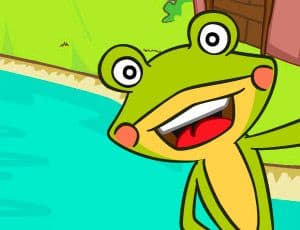Escola Games | Jogos Educativos
https://www.escolagames.com.br
Teacher's support sheet

Animal Groups
Mr. Frog is back!
It will test your knowledge about the animals groups. Prepare to answer questions about: invertebrates, vertebrates, mammals, birds, reptiles, fish, arachnids, insects, crustaceans and amphibians.
After getting 5 questions right, go to the pond to help the teacher feed.

Teacher's tips
Level of education: Elementary School
Age: 07 to 11 years old
Subject: Sciences
Students, in general, are very interested in animals and that is why this game becomes engaging, helping them to make an effort and dedicate themselves in all stages, mainly to find the correct answers and reach the pond to feed Prof. Sapão. Use this game to systematize students' knowledge about the classification of vertebrate and invertebrate animals. Between one group of questions and another, a game to encourage student participation!
Learner outcomes
Know the characteristics of each group of vertebrate and invertebrate animals;
Understand the differences between vertebrate and invertebrate animals;
Name the classes of vertebrate animals;
Name the classes of invertebrate animals;
Differentiate classes of vertebrates;
Differentiate classes of invertebrates;
Fix knowledge acquired in the classroom;
Teachers' goals
Provide students with an understanding of the difference between vertebrate and invertebrate animals;
Offer the game as a didactic resource to fix the content worked in the classroom;
Expand students' knowledge;
Suggestions of approaches for the teacher
(Suggestion 1) Before proposing the game, take pictures of different animals to the room, including those that appear in the game. Propose the construction of posters with the classification of living beings.
(Suggestion 2) Take the students on a tour of the school and the block and ask them to write down all the living things they can see. In class, ask them to separate them into groups (plants, vertebrates, invertebrates).
(Suggestion 3) Take advantage of the subject and introduce the subject of abiotic and biotic components and perform the activity above using this proposal.
(Suggestion 4) Together with the students, build a phylogenetic tree showing the relationship between living beings. Make this activity simple and clear. Do not introduce complex concepts of evolution. Focus on similarities between living things.
More about the content
VERTEBRATE ANIMALS: are those that have vertebrae that form the backbone. They are classified into:
Mammals: feed on mother's milk for some time after birth. Their body is covered with hair. Most mammals are terrestrial. Whales and dolphins are also mammals.
Birds: hatch from eggs. They have a beak, wings and a body covered with feathers.
Reptiles: usually born from eggs. Their bodies are covered with scales, hard plates or shells.
Amphibians: The most striking feature is their life cycle divided into two phases: one aquatic and the other terrestrial, although there are exceptions.
Fish: are aquatic and have limbs transformed into fins or flippers. They breathe through gills or gills. Most have bodies covered in scales.
INVERTEBRATES: are those that do not have vertebrae.
They can be found in water, on land and even in the soil. Invertebrates include all animals without a backbone. Among invertebrates, the most numerous are arthropods (such as insects, spiders, scorpions and crustaceans) and molluscs (such as snails, slugs, shellfish, squid and octopus).
